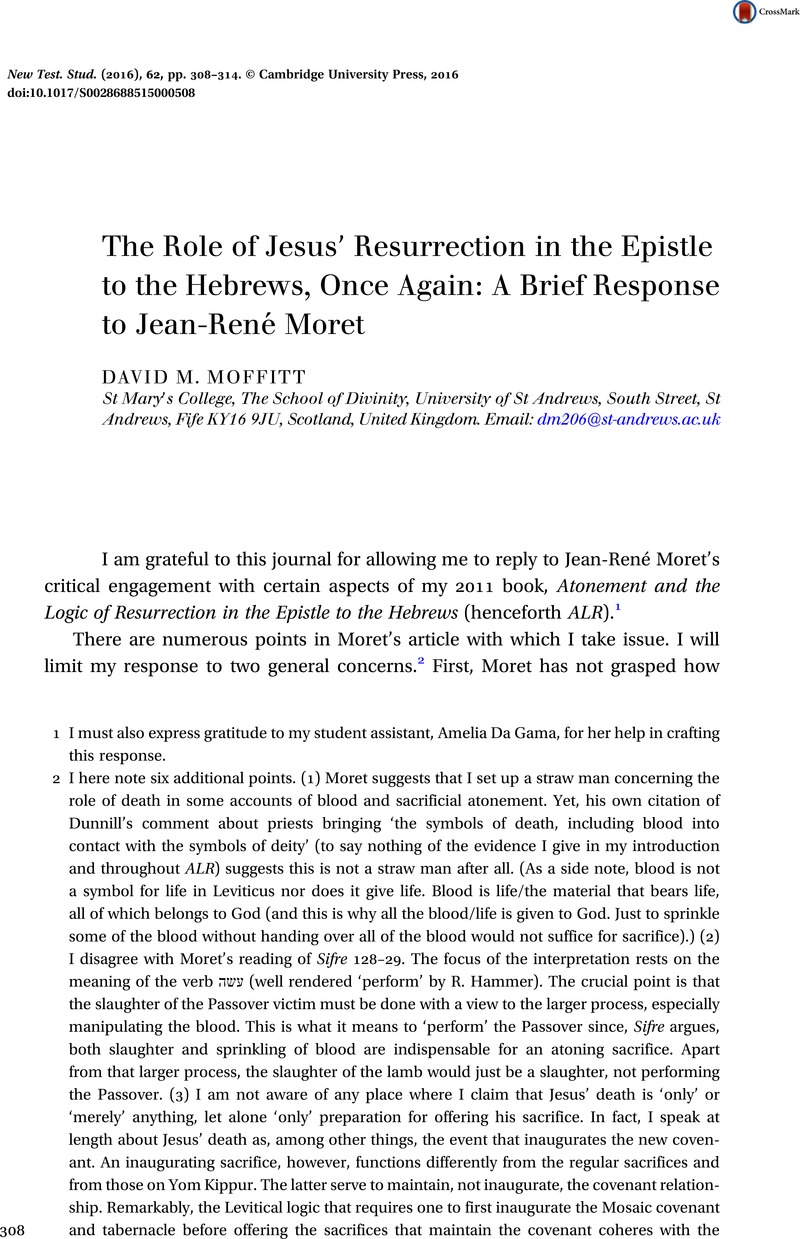Article contents
The Role of Jesus' Resurrection in the Epistle to the Hebrews, Once Again: A Brief Response to Jean-René Moret
Published online by Cambridge University Press: 29 February 2016
Abstract

- Type
- Reply
- Information
- Copyright
- Copyright © Cambridge University Press 2016
References
1 I must also express gratitude to my student assistant, Amelia Da Gama, for her help in crafting this response.
2 I here note six additional points. (1) Moret suggests that I set up a straw man concerning the role of death in some accounts of blood and sacrificial atonement. Yet, his own citation of Dunnill's comment about priests bringing ‘the symbols of death, including blood into contact with the symbols of deity’ (to say nothing of the evidence I give in my introduction and throughout ALR) suggests this is not a straw man after all. (As a side note, blood is not a symbol for life in Leviticus nor does it give life. Blood is life/the material that bears life, all of which belongs to God (and this is why all the blood/life is given to God. Just to sprinkle some of the blood without handing over all of the blood would not suffice for sacrifice).) (2) I disagree with Moret's reading of Sifre 128–29. The focus of the interpretation rests on the meaning of the verb עשה (well rendered ‘perform’ by R. Hammer). The crucial point is that the slaughter of the Passover victim must be done with a view to the larger process, especially manipulating the blood. This is what it means to ‘perform’ the Passover since, Sifre argues, both slaughter and sprinkling of blood are indispensable for an atoning sacrifice. Apart from that larger process, the slaughter of the lamb would just be a slaughter, not performing the Passover. (3) I am not aware of any place where I claim that Jesus' death is ‘only’ or ‘merely’ anything, let alone ‘only’ preparation for offering his sacrifice. In fact, I speak at length about Jesus’ death as, among other things, the event that inaugurates the new covenant. An inaugurating sacrifice, however, functions differently from the regular sacrifices and from those on Yom Kippur. The latter serve to maintain, not inaugurate, the covenant relationship. Remarkably, the Levitical logic that requires one to first inaugurate the Mosaic covenant and tabernacle before offering the sacrifices that maintain the covenant coheres with the notion that Jesus first died to inaugurate the new covenant and then ascended to offer the Yom Kippur sacrifice and intercession that maintains it. (4) I cannot understand what it means to suggest that the act of the high priest interceding in the holy of holies on behalf of God's people can be neatly separated/distinguished from the act of offering sacrifice to God. The high priest can only intercede on behalf of the people in the holy of holies when he is there sprinkling blood on the mercy seat. The two are bound together on Yom Kippur, the only day the high priest can enter the holy of holies. Moret's view does not square with Jewish practice and, in terms of Christology, seems to necessitate a bifurcation between Jesus' person and Jesus' work. (5) Moret's reading of Heb 13.11–12 does not engage with my observations on this text. Heb 13.11 coheres well with my larger argument about the mechanism of atonement – the high priest takes the blood into the holy of holies, then the bodies are burned. Notably, this burning is not done on an altar. In the case of Jesus this is reversed – he suffered outside the camp, then entered the heavenly holy of holies. This is how Jesus sanctifies his people. (6) Moret makes a lot of the role of ransom in Lev 17.11. This is a fair point. This text does not, however, identify the slaughter of the animal in place of the human offerer as the principal atoning or ransoming moment (the life is not given in offering when the animal dies/is slaughtered). This conclusion is clear from the fact that atonement is made ‘on the altar’. But, no animals are slaughtered on any of the Jewish altars.
3 ALR, 43.
4 ALR, 43.
5 ALR, 208–10.
6 ALR, 207 (emphasis original).
7 See ALR, 47–8 n. 2.
8 Kibbe, M., ‘Is It Finished? When Did It Start? Hebrews, Priesthood, and Atonement in Biblical, Systematic, and Historical Perspective’, JTS 65 (2014) 25–61 CrossRefGoogle Scholar. Kibbe's attempt to label my interpretation ‘Socinian’ is surprisingly unfair to Socinus and his followers.
9 ALR, 220–9. I further develop my critique of the standard metaphorical reading of Hebrews' heavenly sanctuary and Jesus' high-priestly ministry in my essay ‘Serving in the Tabernacle in Heaven: Sacred Space, Jesus's High-Priestly Sacrifice, and Hebrews' Analogical Theology’, Hebrews in Context (ed. G. Gelardini and H. W. Attridge; AJEC; Leiden: Brill, forthcoming).
10 See Moret, n. 44.
11 See especially the concluding chapter of ALR.
12 So Wedderburn, A. J. M., ‘Sawing Off the Branches: Theologizing Dangerously Ad Hebraeos ’, JTS 56 (2005) 393–414 CrossRefGoogle Scholar.
13 Moret, n. 29.
- 3
- Cited by




